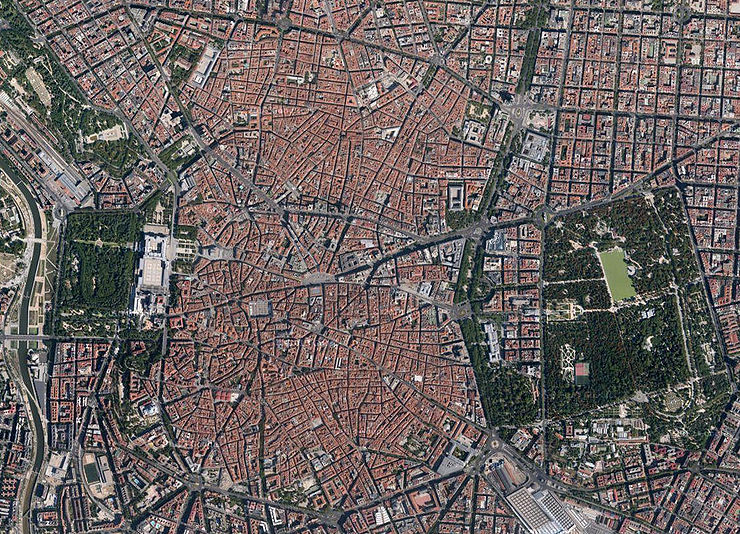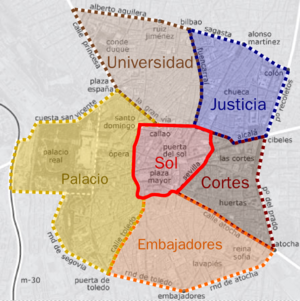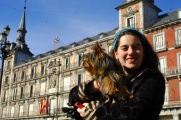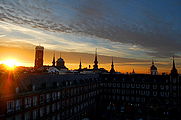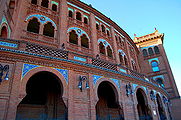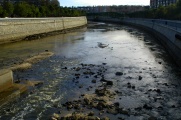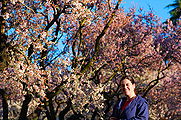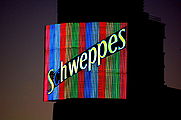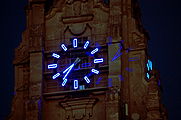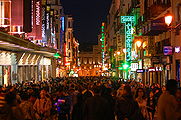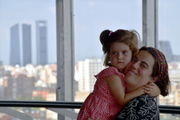Contents |
Madrid
¡Madrid, Madrid! Le prix que je paye, c'est encore quelques heures sans sommeil,
pour me souvenir de toi.
Nilda Fernández.
Madrid is the capital of Spain and of the eponymous autonomous community.

The satellite view below show the extent of the city center from the Palacio Real on the left to el Retiro on the right. Cutting the city in two like a river, the aptly named calle Mayor meets with the Puerta del sol after it grazed by the imposing Plaza mayor (another gigantic depletion in the layout of roofs after Sol itself), and continues afterwards now as the never ending calle de Alcala through the famous Cibeles. Less visible although much bigger, this pattern is repeated by the Gran Via in a northern branch of a Y. The two meet, again like two rivers, at a dull point overlooked by the Victoria Alada of the Metropolis building. The actual river, the Manzanares, grazes the western part of the city as it falls from the mountains, in the distant north.
The panoramic view below was taken on 17 May (2015) from the Cerro de San Pedro, the first mountain of the sierra de Guadarrama, for the surveillance of which the city was built by the Arabs (click to open). You can see Tres Cantos at the bottom (partly cut) and the Universidad Autónoma along with other recognizable highlights of the capital (the four towers, Plaza Castilla, etc.)

Neighbourhoods
The neighbourhoods of the center of Madrid:
See also, the Center of Madrid: |
and in a browsable Google Map:
Mayrit
Madrid was funded by the muslims. It was then known as Mayrit, and was protected by walls circling what is today the neighbourhood of Palacio.
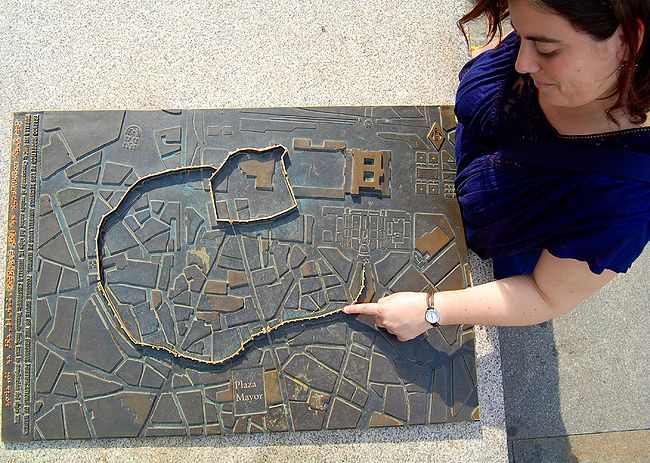
Links
Places of Interest
Plaza Mayor
This is the central square of Madrid and, in a way, of Spain as a whole. Most cities have their Plaza Mayor, With Salamanca ranking second for its specimen of importance and notability.
From 1 January (2014), we lived in Plaza Mayor, on the side of the Casa de la Panadería. We no longer reside there but kept the flat as one of our most cherished possession.
El Retiro
El Retiro is the west end of historical Madrid (nowadays surrounded from the further side by geometrical formations from modern urban planning). The name of this district comes from the famous park del Buen Retiro (of the good retreat).
One everybody's favourite of the park is the monument to the Fallen Angel, that depicts the Milton's inspired fall of the brightest amidst the host of Angels.
- Know then, that, after Lucifer from Heaven
- (So call him, brighter once amidst the host
- Of Angels, than that star the stars among,)
- Fell with his flaming legions through the deep
- Into his place [...]
![]() I like the work because of its ambiguity. The angel is represented as beautiful, while the fall itself is gripping, it seems eternal, never ending, always happening, a real kick from God. There is no angle that seems adequate, the statue falls in all the directions. I use it since 29 December (2013) as the decoration of my social network portals (google+, twitter, YouTube) as an acclaim to this equivocation that allows both satanic sects and devout catholics to both praise and despise the work: as a faithful representation of the Bible or as a tribute to the occult, the evil, the perdition.
I like the work because of its ambiguity. The angel is represented as beautiful, while the fall itself is gripping, it seems eternal, never ending, always happening, a real kick from God. There is no angle that seems adequate, the statue falls in all the directions. I use it since 29 December (2013) as the decoration of my social network portals (google+, twitter, YouTube) as an acclaim to this equivocation that allows both satanic sects and devout catholics to both praise and despise the work: as a faithful representation of the Bible or as a tribute to the occult, the evil, the perdition.
Puerta del Sol
Probably once the most beautiful place of Madrid, when it was marking the limits between the old city and the fields with its eponymous gate, now long gone, it became merely—not the heart, because it is not beating—but more properly, the hub of Madrid. It concentrates various important highlights of the city:
- The former real casa de correos (post office), of New Year Eve's fame. It is now home to the Comunidad de Madrid after being the police headquarters under Franco's rule (Elena's father was incarcerated there for some short amount of time).
- The statue of Charles III dominating the place.
- The Kilómetro Cero, from which national highways are measured.
- The statue of the bear and the Madroño tree, the symbol of Madrid.
- La Mallorquina, a traditional pastry shop (since 1894). Their trufa de chocolate is Elena's family's favourite.
Sadly, although we pass by there virtually everyday, it is for us only a transit point to take the train. The place is popular for all sorts of events and manifestations.
Links
Other places of interest
Churches
- La Almudena, the cathedral of Madrid, consecrated in 1993 only.
- This is a new building because Madrid is a relatively new city, and when it grew to prominence, so did the Spanish empire, making Spaniards build cathedrals in the new world but not in their own capital.
- Iglesia de la Santa Cruz [1], [2].
- La Ermita de San Antonio de la Florida, fresco from and pantheon of Goya.

- The fantastic fresco of Goya picture in an early attempt of his revolutionary style a miracle of Anthony of Padua in the contemporary Madrid (instead of 13th century Lisbon).
Civil buildings
- Mercado de San Miguel.

- A luxury market, plagued by tourists. The building itself is of interest (in iron) and it is supposed to host not just expensive products but a display of delicatessen gastronomy:
- pasar de ser el típico mercado de barrio a un mercado de élite, y sustituir las moscas de la pescadería y los mosquitos de los puestos de frutas por higiénicos expositores convertidos casi en perfectos bodegones. [3]
- A luxury market, plagued by tourists. The building itself is of interest (in iron) and it is supposed to host not just expensive products but a display of delicatessen gastronomy:
Places, squares, gardens
- Plaza de la Villa.
- A beautiful square and the hub of Medieval Madrid, sitting between the Puerta de la Vega and Puerta de Guadalajara, the two main entries of the time [4].
- Jardin Botánico.
- Templo de Debod.
- Rosaleda de Ramón Ortiz.
- Parque del Capricho (pretty but far).
- [Cerro del Tío Pío], aka parque de las siete tetas, nice views for the sunset.
Culture
- Circulo de Bellas Artes.

- El Conde Duque.

Museums
The main three venues:
- El Prado.
 Last time on 26 September 2015
Last time on 26 September 2015
- Reina Sofia.

- Thyssen.

Together they form the so-called Paseo del Arte.
Other museums
- Museo de América.
- Museo de Historia de Madrid.

- Museo Naval de Madrid.
- Casa museo de Lope de Vega (upon reservation/free).
- Museo de la Real Academia de Bellas Artes de San Fernando.
 On 2 of May 2014. [5]
On 2 of May 2014. [5]
- Museo Sorolla.
 On Elena's birthday 2013.
On Elena's birthday 2013.
- Museo de la Fundación Lázaro Galdiano.
- Museo de San Isidro (o de los orígenes de Madrid).

- CaixaForum Madrid. (Mediterráneo. Del mito a la razón.
 On 10 November 2014.)
On 10 November 2014.)
Gastronomy
Pictures
La Mariblanca as if impatient in front of the reloj de Losada en la Puerta del Sol.
Elena and Tizón en la Plaza Mayor.
Cutting a slice of grouper in the Mercado de la Cebada.
The lights of la Gran Vía (on a day that was not that of the beast).
Although with the Telefonica building, it seems the devil does live in Madrid.
Elena and Julia in the Faro de Moncloa on 21 August (2018).
Cultural references
- Madrid Madrid by Nilda Fernandez.
Links
- http://madrider.es
- Madrid at night.
- To do in Madrid (our todo list).
